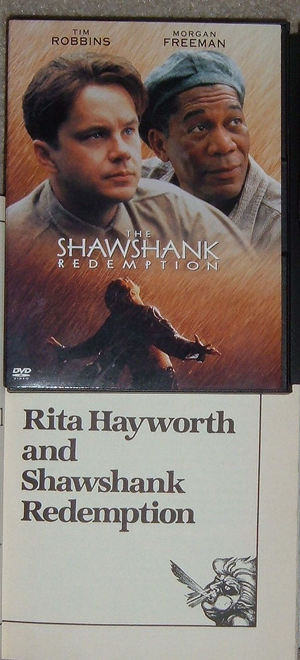Check MateThe Cinematography and Lighting of The Shawshank Redemption
The Shawshank Redemption is a 1994 motion picture adapted and directed by Frank Darabont from a short story by Stephen King. This film is in the classical style combining elements of both formalism and realism. It also combines elements of the dramatic, escapist (prison break), and romantic genres. The film’s symbolism is made apparent through the use of many techniques and elements, but the cinematography and lighting effects have especially important roles to play in this film. This paper will endeavor to illustrate a few of the ways that The Shawshank Redemption’s cinematography and lighting help to make the film into cinematic art.
Classical Cinema
Frank Darabont and Roger Deakins (the film’s cinematographer) have made a truly beautiful classical film. Classical film, of course, being a combination of realistic and formalistic styles gives us the best of both worlds. In The Shawshank Redemption, the use of long takes (realism), closes ups, and slow zooms (formalism) toward the characters make the story intimate enough to affect the audience.
One of the most striking uses of formalism in the film takes place when the “sisters” attack Andy for the first time. In that sequence, the characters are shot in silhouette. This effectively makes the attackers “inhuman.” And the use of silhouette is repeated throughout the film. During the first night that Andy spends in Shawshank the guards savagely beat a crying prisoner. As they drag him from his cell, the guards are in silhouette. It is also interesting to note that we rarely see the guards’ eyes. They are usually hidden by the rim of their hats. It is also important to note that the guards are often seen in groups of three or more and that they are shot from low angles for much of the film to give the impression that they are powerful.
Conversely, the prisoners are often shot from high angles, sometimes even bird’s eye views, to convey their powerlessness. It is only when the prisoners speak to each other that we are on eye level with them. And it is with the prisoners that most of the realistic aspects of the film are noted. The takes with the prisoners are longer and the supporting actors (prisoners) are often seen in three- or two- shots. It is primarily Andy and Red who are shot in close-ups and alone to emphasize how different they are from the other prisoners.
Genre Styling
This film also combines cinematic and lighting styles from several genres. These include (but are by no means limited to) dramatic narrative, escapist or prison break films, and, oddly enough, romances. The lighting in this film, as in any film, is extremely important. What is amazing is how unobtrusive and unnoticed the lighting is until the filmmakers want to make a statement with it.
For example, this film’s exterior shots were done at Mansfield State Reformatory in Ohio (from the film’s credits). Obviously there will be some natural light in these shots. But even with sunny skies, the prisoner’s still look drab and colorless. Part of this is due to the blue/grey costuming and makeup design, but a large part of it is also due to the fact that the prisoners are always shot from the shadow side of their faces. They are never shown with the sun beaming directly down on their faces until Andy plays the aria for them. In that shot, the camera sweeps over the heads of the prisoners as they stand looking up at the speakers and the sun finally hits them fully as Red explains that, just for a moment, they all felt like free men.
Low key lighting is used heavily throughout the film. This plays into the dramatic narrative genre and creates a visual cue to the internal conflict that the film’s characters are experiencing. But another interesting genre style used is from the escapist genre. When Andy first enters Shawshank, he walks through a huge stone archway. As he does this, the camera pans up the stone from the entrance all the way to the top of the building. The prison effectively “swallows” Andy.
Another example of this genre is the way that the cinematographer and director have framed the shots in the prison yard. Even when Andy and Red sit atop the bleachers, they can never see over the stone walls. They are trapped, imprisoned, and so too are we, the viewers. There is nothing besides Shawshank. No outside world at all. To emphasize this, all the windows that the prisoners could look out of (the library, the cafeteria, etc…) are dirty and although they let light in, we never get to actually see through their opaque layers.
As for the romantic genre, one of its conventions is to use warm colors and gels to highlight a character and give clues to their internal states. The filmmakers take special pains to do that with Andy because Tim Robbins plays him from a very internal and self-contained point of view. Throughout the film Andy is seen bathed in reddish light. This starts at the very opening when Andy sits in his car illuminated by the harsh red light from the radio. That harsh red (anger, passion, hatred) is softened considerably when Andy enters Shawshank. Suddenly the light conveys to us that Andy is a romantic character. He is the only one who chooses to cling to hope on the inside. Even after he was wrongfully convicted of murder he manages to remain a quiet, passionate, and thoughtful man in the face of prison life. The use of red for Andy is an amazingly appropriate choice to have been made in this kind of film.
Symbolism
And now comes my very favorite part of the paper: symbolism! And let me tell you, ambiguous other, this movie is chock full of it! One of the first motifs to become apparent to me was shoes. There are numerous shots of shoes as both the prisoners and the guards walk. When Brooks hangs himself, we see his shoes as he steps onto the table, and then we see his feet “dance” when he knocks the table over. Of course, all these shoes have been carefully placed into our subconscious because when Andy escapes, he takes the Warden’s shiny shoes with him.
Another symbolic motif in the film is the use of chess as a metaphor. Andy requests his rock hammer to make chess pieces of alabaster and onyx. In most of the prison yard shots, Andy is framed by grey stone in the background and Red is framed by red stone. This makes them both players on an invisible chess board. But it is interesting to note that in the third act of the film, when Andy gains the upper hand and the internal states of the men shift, Andy begins to be seen against red stone and Red against grey.
Also, there is a shot of the chess board in front of the poster in Andy’s cell. If you look past this symbolic placement, you will see that the white bishop is missing from the set. One could theorize that this missing bishop could represent the way that the hypocritically religious Warden will be eliminated by the end of the film. In any case, the filmmakers do a beautiful job of setting up this real life chess game with Andy being the only real player and everyone else being a pawn.
The last motif I saw is actually a prison break motif. The Count of Monte Cristo is referenced in the film and is even referred to as a book about a prison break. In the film, just as in the book, a prisoner tunnels his way through rock to gain freedom and ultimately “finds treasure” in the outside world both monetarily and by taking revenge on his captors. Another way that the prison break motif is represented is by the placement of the rock hammer in the chapter of the Bible called “Exodus”. This chapter has to do with the Israelites escaping from Pharaoh and finding their promised land, just as Andy finds his in Mexico.
And I simply can’t end this paper without mentioning the opera aria that Andy plays. It is Sull’ Aria, a duettino between Susannah and the Countess in Mozart’s The Marriage of Figaro. Sull’ Aria translates as “to Romeo.” This aria takes place in the opera’s third act and depicts Susannah (the Countess’s maid) and the Countess herself as they plot revenge against the Count who keeps making advances toward the already engaged Susannah. I believe that this song was used for several reasons.
Firstly, this is a classical piece with romantic overtones. As Andy is shown as a romantic character, even his choosing of this song reinforces this portrayal, this song is clearly appropriate. Also, it is a song of cunning and of laying the grounds for an escape from oppression as Susannah will never have to ward of the Count again if their plan works. This makes the aria’s inclusion even more meaningful to the overall film and Andy’s character.
Conclusion
In conclusion, this paper has sought to show the ways in which cinematography and lighting can contribute to a film’s style, genre, and symbolism. The Shawshank Redemption is a wonderful representation of both classicism and the ways that a well made film can affect you long after the credits have rolled.





